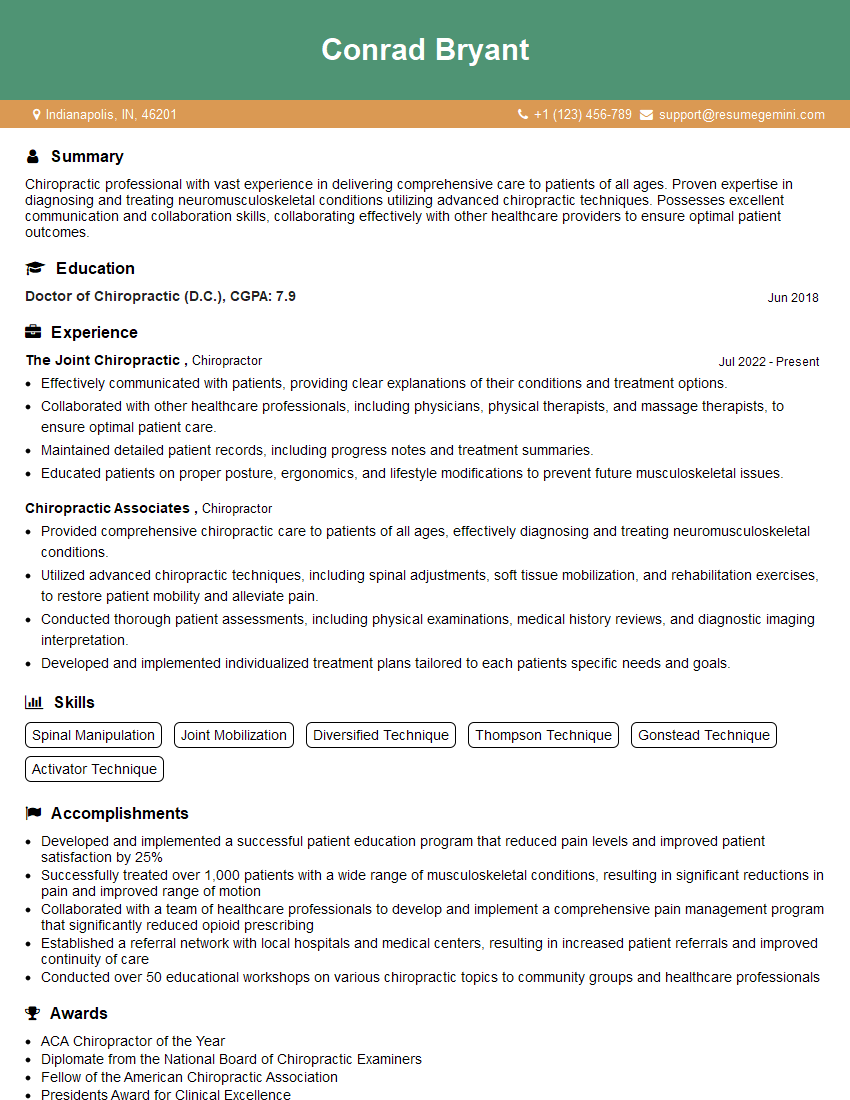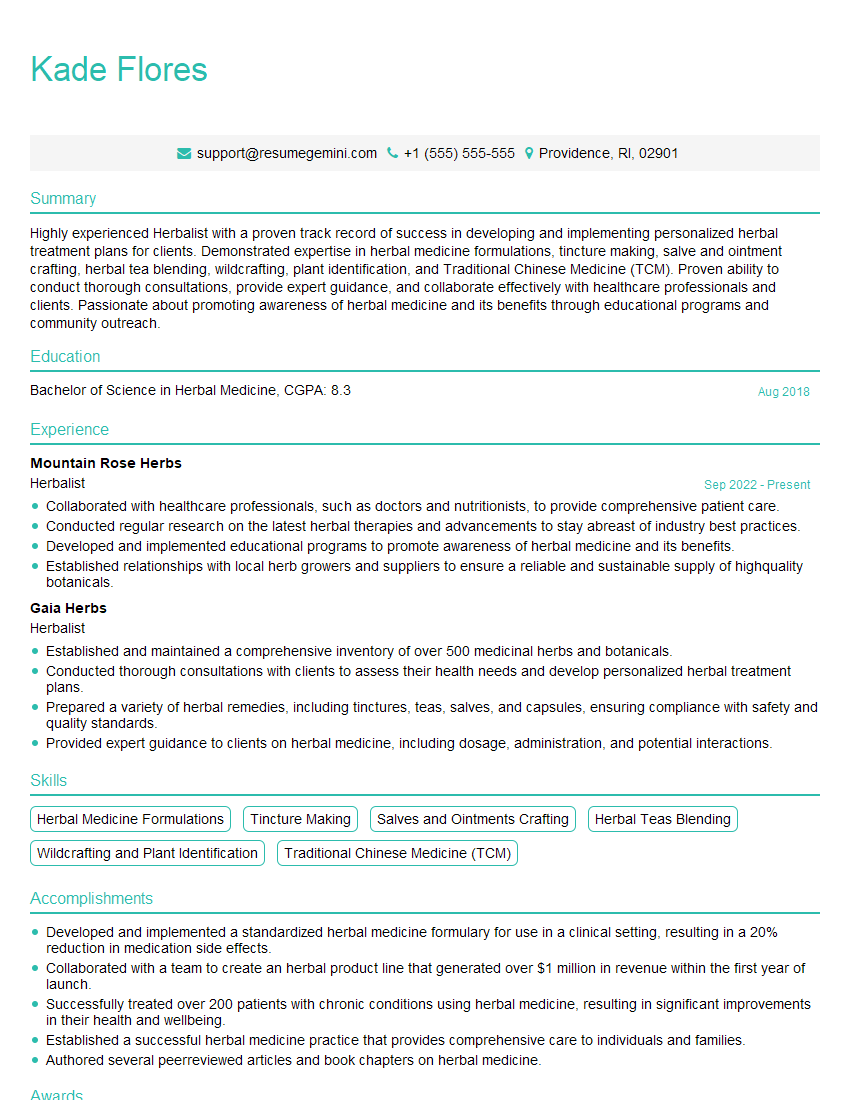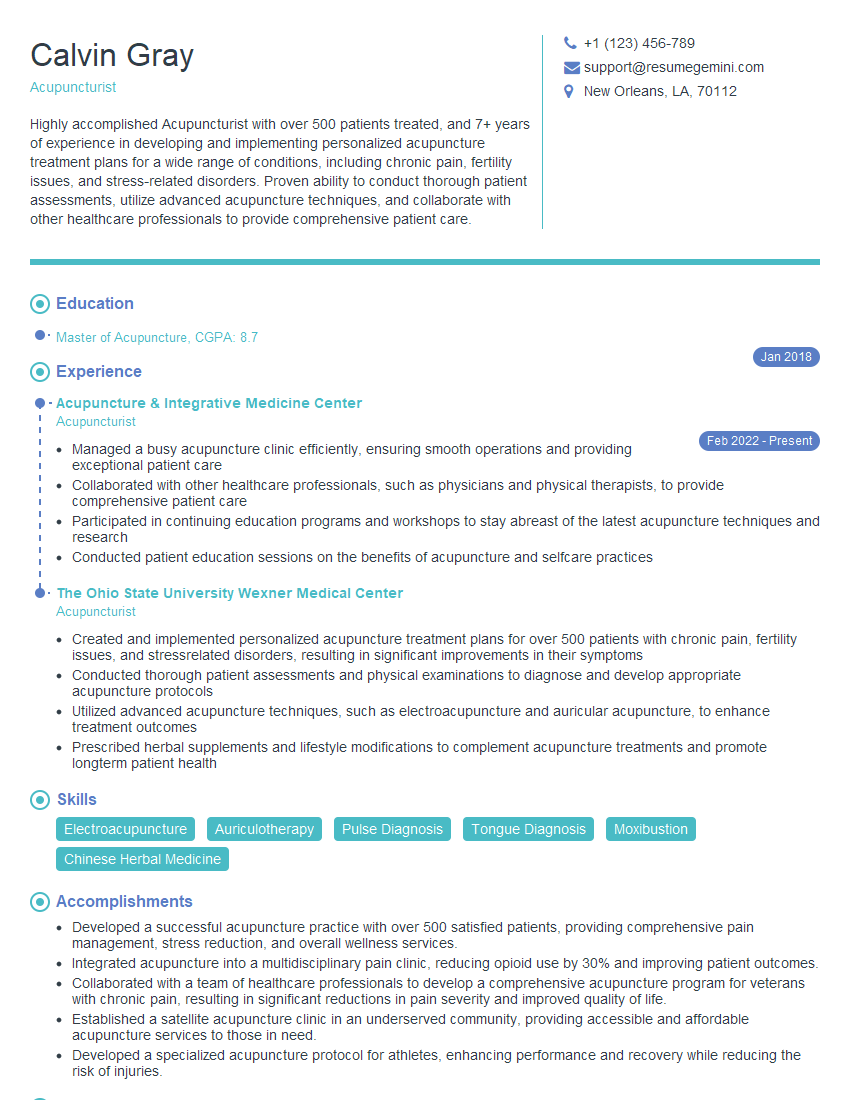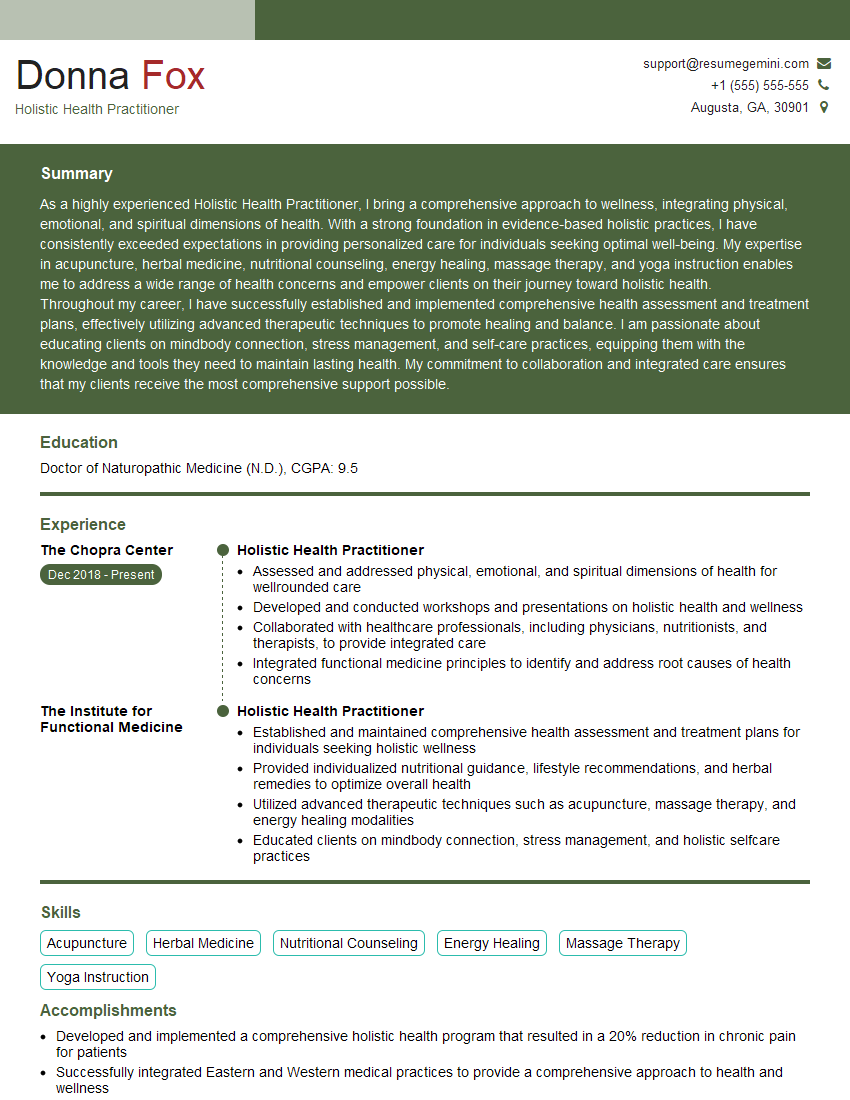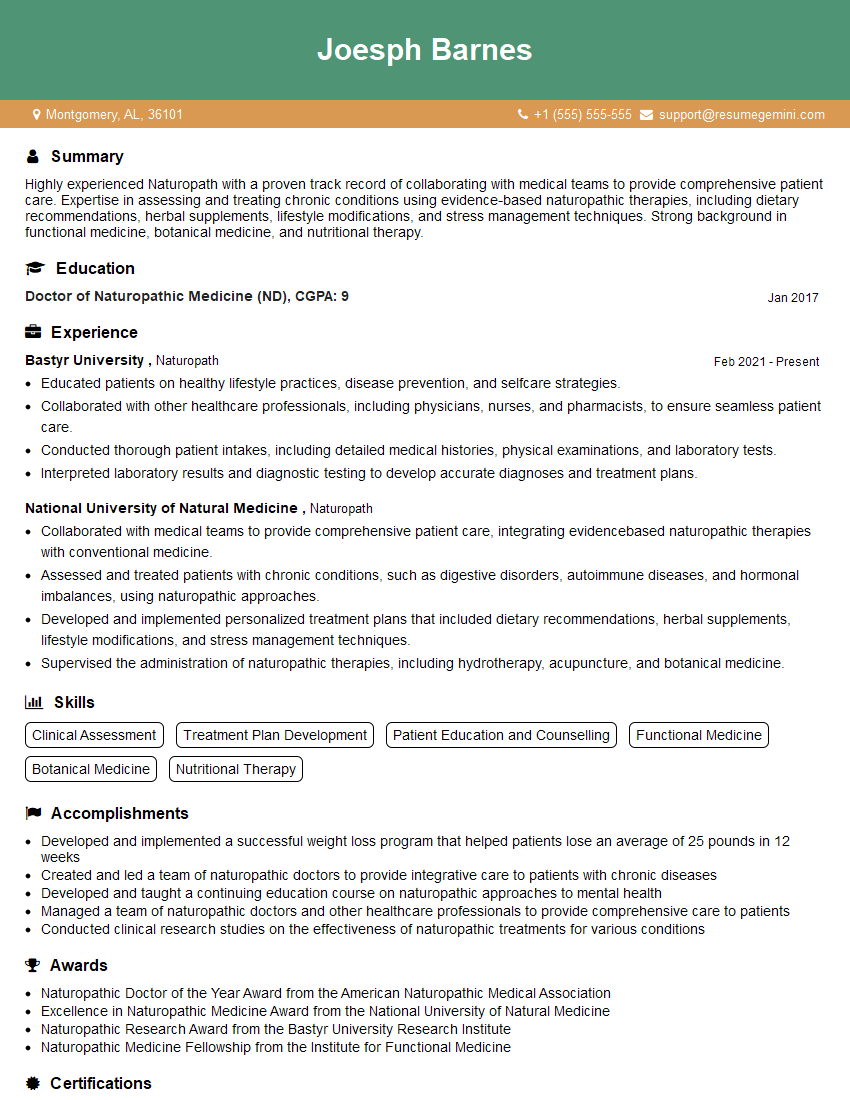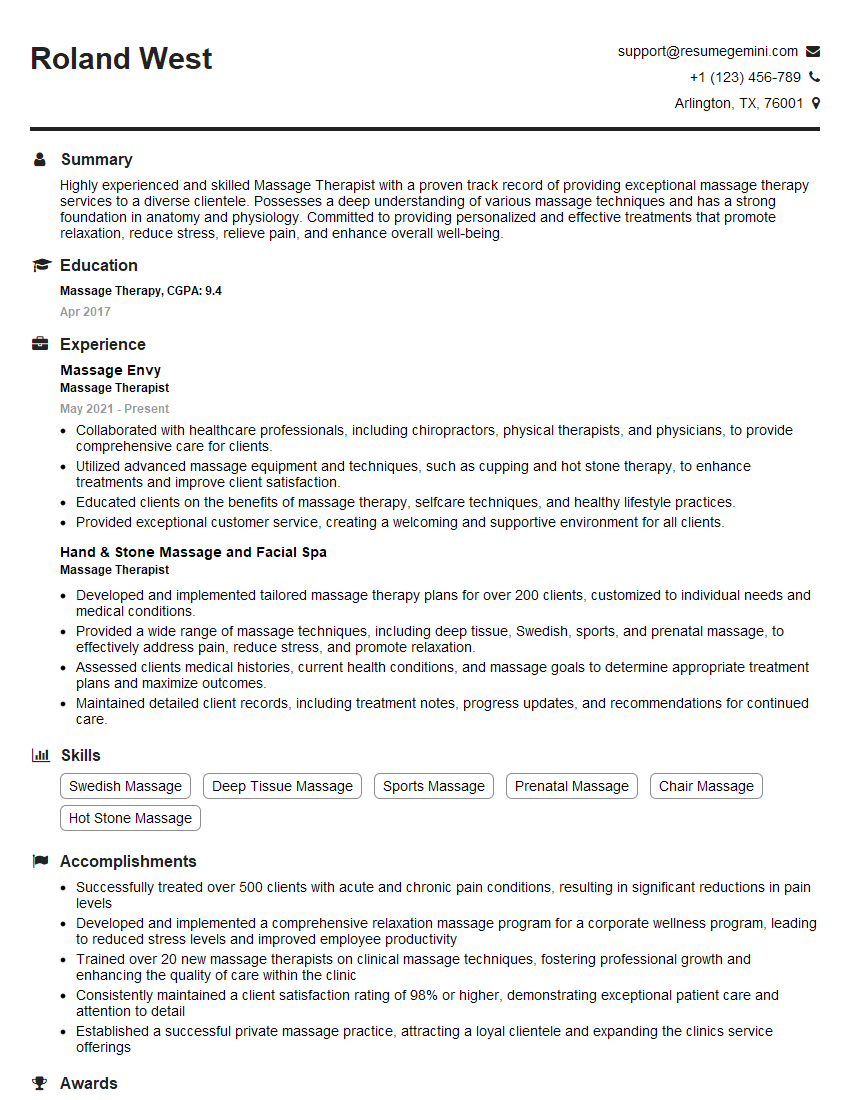Interviews are more than just a Q&A session—they’re a chance to prove your worth. This blog dives into essential Deep Understanding of Alternative Healing Practices interview questions and expert tips to help you align your answers with what hiring managers are looking for. Start preparing to shine!
Questions Asked in Deep Understanding of Alternative Healing Practices Interview
Q 1. Explain the principles of Traditional Chinese Medicine (TCM).
Traditional Chinese Medicine (TCM) is a holistic system of healing that emphasizes the balance of Qi (vital energy) within the body. It’s based on the understanding that health is maintained through the harmonious flow of Qi along meridians, pathways through which energy circulates. Imbalances in Qi, often caused by internal or external factors (like stress or poor diet), are believed to lead to illness. TCM aims to restore this balance through various methods.
- Yin and Yang: This fundamental principle describes the interconnected and opposing forces in nature and the body. Maintaining a balance between these two forces is crucial for health.
- Five Elements: Wood, Fire, Earth, Metal, and Water represent the cyclical relationships between different organs and systems. Understanding these relationships helps to diagnose and treat imbalances.
- Diagnosis: TCM practitioners use methods like pulse diagnosis, tongue examination, and observation of symptoms to assess an individual’s energetic state.
- Treatment Modalities: Common treatment modalities include acupuncture, herbal medicine, Tuina (massage), dietary therapy, and Qi Gong (energy exercises).
For example, if someone experiences digestive issues, TCM might identify an imbalance in the Earth element, potentially addressing it through dietary changes focusing on foods that support the spleen and stomach, or acupuncture at specific points along the relevant meridians.
Q 2. Describe the benefits and limitations of acupuncture.
Acupuncture, a key component of TCM, involves inserting thin needles into specific points on the body’s meridians to stimulate Qi flow and alleviate pain or other symptoms.
Benefits: Acupuncture has shown effectiveness in managing chronic pain conditions like back pain, headaches, and osteoarthritis. It can also help with nausea, anxiety, and insomnia. The benefits are often attributed to the release of endorphins and other neurochemicals that influence pain perception and relaxation. I’ve personally seen significant improvements in patient mobility and pain levels after a course of acupuncture for chronic back pain.
Limitations: Acupuncture isn’t a cure-all and its effectiveness varies between individuals and conditions. It’s crucial to find a licensed and experienced acupuncturist. Some people experience mild side effects like bruising or soreness at the needle insertion points. Furthermore, high-quality, robust scientific evidence supporting its effectiveness for all conditions is still evolving.
Q 3. What are the key differences between Ayurveda and Western medicine?
Ayurveda, originating in India, and Western medicine differ significantly in their philosophies and approaches to health and disease.
- Holistic vs. Reductionist: Ayurveda considers the individual’s physical, mental, and spiritual well-being, treating the whole person rather than just the disease. Western medicine tends to focus on identifying and treating specific diseases through targeted interventions. For instance, addressing a heart issue from an Ayurvedic perspective would involve lifestyle modifications, diet, herbs, and potentially other modalities to support the body’s overall balance.
- Disease Etiology: Ayurveda emphasizes the body’s constitution (doshas) and their imbalance as the root cause of disease. Western medicine typically focuses on identifying pathogens, genetic factors, or physiological abnormalities.
- Treatment Approach: Ayurveda uses personalized approaches tailored to the individual’s constitution, utilizing herbs, diet, lifestyle adjustments, yoga, and meditation. Western medicine primarily employs pharmaceuticals, surgery, and other advanced technologies.
- Preventive Care: Both systems promote preventive care, but Ayurveda places a strong emphasis on maintaining a healthy lifestyle to prevent imbalances from occurring in the first place.
A practical example is the treatment of high blood pressure. Western medicine might prescribe medication to lower blood pressure. Ayurveda would address it by examining the individual’s constitution, suggesting dietary changes, stress reduction techniques like meditation, and possibly herbal remedies to support cardiovascular health.
Q 4. How do you assess a patient’s energy field?
Assessing a patient’s energy field, often called an aura, is a subjective process relying on subtle energy perception. There’s no standardized scientific instrument for measuring it. Practitioners may use different techniques, but it often involves a combination of:
- Intuitive Sensing: This involves using one’s intuition and sensitivity to perceive energy patterns around the body. It might manifest as warmth, coolness, tingling sensations, or visual perceptions of color and light. I personally feel this as a subtle shift in temperature or pressure near the patient.
- Visual Observation: Some practitioners claim the ability to see the aura visually, describing it as a shimmering field of light surrounding the body.
- Kinesthetic Sensing: This involves using the hands to sense energy flow and blockages, feeling variations in texture, temperature, or vibration.
It’s crucial to emphasize that this assessment method is not universally recognized within mainstream medical science and is considered a subjective assessment that needs validation with traditional medical tests.
Q 5. Explain your understanding of the mind-body connection in healing.
The mind-body connection is central to my understanding of healing. Emotional and psychological stress significantly impacts physical health. Chronic stress can contribute to various health problems, including cardiovascular disease, autoimmune disorders, and gastrointestinal issues.
Conversely, positive emotions and mental well-being can enhance the body’s healing capacity and resilience. Practices like meditation, mindfulness, and psychotherapy can help individuals manage stress, improve their emotional regulation, and enhance their overall health. For example, I’ve worked with clients experiencing chronic headaches who found significant relief after incorporating mindfulness techniques and addressing underlying emotional stressors.
My approach integrates this understanding into treatment plans, encouraging clients to explore the emotional aspects of their health, often utilizing modalities such as meditation, visualization, or expressive arts therapies.
Q 6. Describe your experience with herbal remedies and their potential interactions.
I have extensive experience with herbal remedies, understanding their potential therapeutic benefits and risks. Herbal remedies, unlike pharmaceuticals, usually have a gentler action and are often used to support the body’s natural healing processes. However, it is vital to approach herbal remedies with caution and understanding due to potential interactions and side effects.
Potential Interactions: Herbal remedies can interact with prescription medications or other supplements. For instance, St. John’s Wort, often used for depression, can interact with many medications, including birth control pills. I meticulously review a patient’s medical history and current medications before recommending any herbal remedies, consulting medical literature as needed to rule out contraindications. This comprehensive approach minimizes the risk of adverse reactions.
Safety and Quality: The quality and purity of herbal products vary widely. It is important to source herbs from reputable suppliers to ensure they are free from contaminants and accurately labeled.
Q 7. What are the contraindications for Reiki treatment?
Reiki, a Japanese energy healing technique, is generally safe, but there are some contraindications to consider:
- Pregnancy (first trimester): While some practitioners may offer modified Reiki sessions, caution is advised in the first trimester.
- Severe Mental Illness: Individuals with severe mental illness might experience heightened sensitivity or emotional distress during Reiki.
- Recent Surgery or Injury: It’s best to avoid Reiki immediately following surgery or a significant injury until healing is well underway.
- Bleeding Disorders: Reiki might not be suitable for those with bleeding disorders, as it can influence circulation.
- Organ Transplant Recipients: Reiki is not generally advised until a period after an organ transplant.
- Individuals with Pacemakers or other implants: I would always advise consulting with a physician and only using Reiki after careful consideration and consultation with the cardiologist.
It’s important to inform the Reiki practitioner of any pre-existing medical conditions before treatment. A good practitioner will always assess the individual’s suitability for Reiki and adjust the session accordingly.
Q 8. How would you address a patient’s skepticism towards alternative therapies?
Addressing skepticism towards alternative therapies requires a compassionate and evidence-based approach. It’s crucial to acknowledge the patient’s concerns and validate their right to be cautious. Instead of dismissing their doubts, I begin by explaining the principles of the chosen therapy in clear, simple terms, avoiding overly technical jargon. I emphasize the importance of informed consent and shared decision-making. I might share success stories (while maintaining patient confidentiality) or refer them to reputable research studies supporting the therapy’s efficacy for specific conditions. For example, if discussing acupuncture, I might explain its mechanism of action involving meridians and energy flow, and then present studies showing its effectiveness in managing chronic pain. The key is to build trust and empower the patient to make an informed choice. I also let them know that it’s perfectly acceptable to combine alternative therapies with conventional medicine, if they choose.
Q 9. Explain the concept of chakras and their role in energy healing.
In energy healing, chakras are visualized as seven spinning vortexes of energy located along the spine, each associated with specific aspects of physical, emotional, and spiritual well-being. These energy centers, when balanced, contribute to overall health and vitality. An imbalance, often expressed as physical or emotional distress, is believed to occur when the flow of energy through the chakras is disrupted. Energy healing modalities aim to restore this balance by clearing blockages and promoting healthy energy flow. For instance, the root chakra (Muladhara), located at the base of the spine, is associated with security and grounding. If a patient experiences intense anxiety, we might explore techniques to address a potential blockage in this chakra, using methods such as visualization, breathwork, or crystal healing, to facilitate its healthy functioning and alleviate symptoms. Similarly, the heart chakra (Anahata) is associated with love and compassion, and imbalances here might manifest as relationship difficulties or emotional coldness. Working with the chakras is a holistic approach, understanding that each influences the others in a complex interplay.
Q 10. Discuss the ethical considerations involved in alternative healing practices.
Ethical considerations in alternative healing practices are paramount. Practitioners must prioritize patient safety and well-being above all else. This includes being transparent about the limitations of the therapy and not making unsubstantiated claims. It’s crucial to avoid conflicts of interest and maintain professional boundaries. Informed consent is essential—patients must understand the nature of the treatment, potential risks and benefits, and alternative options. Confidentiality must be strictly maintained. Furthermore, practitioners should continually update their knowledge and skills to ensure they provide safe and effective care. Misrepresenting qualifications or using misleading marketing tactics is unethical and potentially harmful. A key challenge is navigating the fine line between encouraging belief in the healing process and making promises that can’t be kept. Ultimately, ethical practice hinges on respect for the patient’s autonomy and the prioritization of their well-being.
Q 11. How do you maintain client confidentiality in your practice?
Maintaining client confidentiality is a cornerstone of my practice. I adhere to strict privacy protocols, including securely storing all client records (both physical and electronic) and using encryption where necessary. I never discuss patient information with anyone outside the treatment context unless legally obligated to do so (e.g., suspected abuse). I obtain informed consent before using any information for research or teaching purposes, ensuring anonymity whenever possible. I also emphasize the importance of confidentiality in my initial consultations, making it clear that all conversations and information shared will be treated with the utmost respect and discretion. I’m committed to ongoing professional development in data protection and ethical practices to ensure that client information remains secure and private.
Q 12. Describe your approach to integrating alternative and conventional medicine.
My approach to integrating alternative and conventional medicine is collaborative and patient-centered. I believe that both systems offer valuable tools for addressing health concerns and that they can often complement each other effectively. For example, a patient with chronic back pain might receive conventional treatment such as physiotherapy alongside alternative therapies like acupuncture or massage to manage pain and improve mobility. I always emphasize open communication between the patient, myself, and their conventional healthcare providers, sharing relevant information to ensure holistic care. The patient remains in control of their treatment plan, and my role is to provide additional support within my area of expertise, never supplanting or interfering with prescribed medical interventions. This approach respects the individual’s beliefs and preferences and seeks to optimize their overall health outcomes.
Q 13. What are your preferred methods for assessing patient progress?
Assessing patient progress requires a multi-faceted approach. I use both subjective and objective measures. Subjectively, I regularly gather feedback from the patient through open-ended questions and standardized questionnaires assessing their perceived improvement in symptoms, quality of life, and overall well-being. Objectively, depending on the therapy, I might monitor physiological changes, such as heart rate variability (HRV) in biofeedback or range of motion improvements in physical therapies. Regularly scheduled follow-up sessions allow for a continuous evaluation of the treatment’s effectiveness. The methods used depend on the specific therapy and the patient’s individual needs. Data collected is documented meticulously, allowing for a detailed overview of the patient’s journey and a clear picture of the therapy’s impact. This approach provides a comprehensive and reliable way to track progress and adjust the treatment as needed.
Q 14. How do you handle difficult or challenging patients?
Handling difficult or challenging patients requires patience, empathy, and a strong understanding of therapeutic boundaries. The key is to maintain open and honest communication, actively listening to their concerns without judgment. I strive to understand the root of the difficulty—is it related to the treatment itself, their personal circumstances, or unmet expectations? If the challenges stem from unrealistic expectations, I re-educate the patient on the therapy’s limitations. If the challenges are related to personal issues impacting their progress, I may offer referrals to appropriate professionals. In cases of boundary violations or disruptive behavior, I’ll clearly communicate my professional boundaries and, if necessary, may terminate the therapeutic relationship. Maintaining a compassionate yet firm approach ensures the safety and well-being of both the patient and myself while maintaining professional integrity.
Q 15. Describe a time you had to adapt your treatment plan due to unexpected patient response.
Adapting treatment plans is crucial in alternative healing, as each individual responds uniquely. For instance, I was treating a patient with chronic back pain using acupuncture and herbal remedies. The initial plan focused on points associated with meridians related to the kidneys and liver, as we suspected a Qi stagnation. However, after several sessions, the patient reported increased pain instead of relief. This unexpected response led me to reassess the diagnosis. We discovered through further questioning that the pain was worsening during specific times, suggesting a possible emotional component.
I adjusted the treatment plan to incorporate emotional release techniques such as guided meditation and energy healing, alongside modified acupuncture points targeting emotional regulation. We also adjusted the herbal formula to address stress and improve emotional balance. This integrated approach, adapted to the patient’s specific response, ultimately yielded positive results, significantly reducing the patient’s pain and improving overall well-being. This highlighted the importance of continuous assessment and the flexibility needed in alternative healing practices.
Career Expert Tips:
- Ace those interviews! Prepare effectively by reviewing the Top 50 Most Common Interview Questions on ResumeGemini.
- Navigate your job search with confidence! Explore a wide range of Career Tips on ResumeGemini. Learn about common challenges and recommendations to overcome them.
- Craft the perfect resume! Master the Art of Resume Writing with ResumeGemini’s guide. Showcase your unique qualifications and achievements effectively.
- Don’t miss out on holiday savings! Build your dream resume with ResumeGemini’s ATS optimized templates.
Q 16. Explain your understanding of the placebo effect and its role in healing.
The placebo effect is a powerful phenomenon where a patient experiences a therapeutic benefit from a treatment or intervention despite it lacking inherent medicinal properties. This effect isn’t simply ‘all in their head’; it involves complex neurobiological mechanisms. The belief in the treatment’s efficacy, the expectation of healing, and the patient-practitioner relationship all play a role in triggering the body’s natural healing processes.
In alternative healing, understanding the placebo effect is crucial because it can contribute significantly to the overall outcome. It’s not something to be dismissed, but rather incorporated ethically and thoughtfully into practice. For example, a practitioner’s genuine empathy and belief in the therapeutic modality can positively influence a patient’s expectations and amplify the treatment’s effectiveness, even if that treatment itself is subtle, such as a gentle touch therapy. However, it is ethically imperative to avoid misleading patients into believing a treatment is more effective than it is demonstrably shown to be. Ethical practice requires clarity and transparency about the nature of the intervention and its limitations.
Q 17. How do you stay up-to-date on the latest research in alternative healing?
Staying current in the rapidly evolving field of alternative healing requires a multi-pronged approach. I regularly subscribe to and actively read peer-reviewed journals specializing in complementary and alternative medicine (CAM). This includes publications focusing on specific modalities I utilize, such as acupuncture journals, publications on herbal medicine research, and those encompassing energy healing research. I also attend conferences and workshops to learn about the latest research findings, new techniques, and best practices from leading experts in the field.
Furthermore, I actively participate in professional organizations related to my chosen modalities. These organizations provide access to webinars, continuing education opportunities, and discussions with colleagues, helping to expand my knowledge base and foster a community of learning. Finally, I maintain a comprehensive library of relevant books and publications. Continual learning is integral to providing ethical and effective care.
Q 18. What are the legal and regulatory requirements for your chosen modality?
Legal and regulatory requirements for alternative healing practices vary widely depending on the specific modality, geographic location, and licensing board. In my practice, which includes acupuncture and herbal medicine, I am required to hold a valid state license for acupuncture, which involves fulfilling specific educational requirements and passing rigorous examinations. The regulations regarding herbal medicine are often less defined but still require adherence to standards of purity, safety, and proper labeling of products.
Additionally, there are regulations regarding patient privacy (HIPAA compliance), informed consent, advertising practices, and record-keeping. Staying abreast of these evolving regulations requires continuous professional development and diligent attention to detail to ensure ethical and legal compliance.
Q 19. Describe your approach to patient education and empowerment.
Patient education and empowerment are central to my approach. I believe that true healing involves a partnership where the patient is an active participant in their own recovery journey. My approach begins with a thorough initial consultation where I aim to build trust and rapport, listening carefully to the patient’s concerns and understanding their perspective. I then provide clear and concise explanations of the proposed treatment plan, its potential benefits, risks, and limitations, ensuring they are completely informed and comfortable with proceeding.
Throughout the treatment process, I encourage patients to actively engage in their care by asking questions, expressing concerns, and sharing feedback. I strive to empower them by teaching them self-care techniques such as simple Qi Gong exercises, mindful breathing techniques, or dietary recommendations that complement their treatment, allowing them to continue the healing process beyond the session. This collaborative and empowering approach fosters a sense of responsibility and agency, leading to more sustainable and lasting results.
Q 20. How would you handle a situation where a patient’s beliefs conflict with your recommendations?
Respecting patient autonomy is paramount in alternative healing. When a patient’s beliefs conflict with my recommendations, I employ a compassionate and collaborative approach. I begin by actively listening to understand the patient’s perspective and concerns without judgment. I then work to find common ground by exploring the shared goals of improving their well-being. This may involve explaining the rationale behind my recommendations in a clear and respectful way, using analogies or examples that resonate with their understanding.
If we can’t reach a consensus, I might suggest alternative strategies that align more closely with their beliefs while still aiming for the same outcome. If a patient insists on a path that I deem to be unsafe or ineffective, I will explain the potential risks and limitations clearly. While respecting their choice, I might also suggest a referral to another practitioner or medical professional whose approach is better aligned with their preferences. In such situations, transparency, clear communication, and mutual respect are essential to maintaining the therapeutic relationship.
Q 21. What are your professional affiliations and certifications?
I am a licensed Acupuncturist and hold a certification in Herbal Medicine from the [Name of Institution]. I am a member of the [Name of Professional Organization] and maintain active membership in good standing. My licensure is current and compliant with all relevant state regulations. My certifications and affiliations represent my commitment to continuing education and upholding high standards of professional practice within the field of alternative medicine. I regularly participate in professional development activities to stay updated on advancements in the field.
Q 22. Explain your approach to continuing professional development.
Continuing professional development (CPD) is crucial for staying at the forefront of alternative healing. My approach is multifaceted and focuses on a blend of formal and informal learning. Formally, I actively participate in workshops, conferences, and advanced training courses focusing on specific modalities like advanced massage techniques, energy healing certifications, and the latest research in complementary medicine. For example, I recently completed a specialized course on craniosacral therapy, expanding my treatment options. Informally, I engage in ongoing self-study through journals, books, and online resources, consistently updating my knowledge on evidence-based practices and emerging trends in the field. I also actively participate in peer supervision groups, where we discuss cases and learn from each other’s experiences, fostering continuous growth and refinement of my skills.
Q 23. How do you ensure the safety and efficacy of your treatments?
Ensuring safety and efficacy is paramount. My approach involves several key steps: Firstly, a thorough intake process is crucial. This involves detailed client history, physical assessment (where appropriate), and discussion of their goals and expectations. Secondly, I clearly communicate the limitations of alternative therapies and their potential interactions with conventional medicine. Thirdly, I always prioritize informed consent; clients fully understand the procedure, potential risks, and benefits before proceeding. I continuously monitor my client’s response during and after each treatment, adjusting the approach as necessary. For example, if a client experiences discomfort during a massage, I immediately modify the pressure and technique. Finally, I maintain detailed records of each session, tracking progress and any adverse reactions, allowing for continuous evaluation and improvement of my practice. I also uphold a high standard of hygiene and sanitation in my treatment area.
Q 24. Describe your experience with different types of massage techniques.
My experience encompasses a wide range of massage techniques. I’m proficient in Swedish massage, focusing on relaxation and improved circulation. I’m also skilled in deep tissue massage, addressing chronic muscle pain and tension. Furthermore, my training includes trigger point therapy, effectively targeting specific points of muscle tension, and sports massage, specializing in addressing the needs of athletes. My experience extends to aromatherapy massage, incorporating essential oils to enhance the therapeutic benefits. Each technique is tailored to the individual client’s needs and preferences, considering their medical history and specific goals. For example, a client with fibromyalgia might benefit from a gentler approach like Swedish massage combined with aromatherapy, while an athlete recovering from an injury might require more focused deep tissue or sports massage.
Q 25. What is your experience with diagnosing and treating specific health conditions using alternative methods?
It’s important to preface this by stating that alternative methods are complementary, not replacements, for conventional medical diagnosis and treatment. While I don’t diagnose illnesses, I work with clients experiencing various conditions. For instance, I’ve helped clients manage stress and anxiety through techniques like Reiki and meditation. Massage therapy has proven effective in alleviating symptoms of musculoskeletal pain, such as backaches and headaches. I’ve also worked with clients experiencing insomnia, utilizing techniques like relaxation massage and guided imagery to improve sleep quality. It is crucial to emphasize that these alternative methods support well-being and symptom management; they do not replace the need for appropriate medical care from a licensed healthcare professional when dealing with serious health issues. Any significant health concerns always necessitate consultation with a physician.
Q 26. Explain your understanding of different energy healing modalities.
Energy healing modalities involve working with the body’s subtle energy fields to promote healing and balance. I have extensive experience with Reiki, a Japanese technique involving gentle touch or hands-off placement to facilitate energy flow. I am also trained in Qigong, a Chinese practice that combines movement, meditation, and breathing to cultivate vital energy. Furthermore, I incorporate principles of chakra balancing, addressing energy centers within the body to promote emotional, physical, and spiritual well-being. Each modality approaches energy healing differently, but the underlying principle is the same: restoring balance and promoting self-healing within the individual. I select the most appropriate modality based on the client’s needs and preferences, always ensuring a safe and comfortable environment.
Q 27. How do you integrate spirituality into your alternative healing practice (if applicable)?
Spirituality plays a significant role in my practice, but always with respect to the client’s beliefs and preferences. I believe that healing is a holistic process involving the mind, body, and spirit. While I don’t impose my beliefs, I create a space for clients to explore their own spiritual connection if they choose. This might involve incorporating mindfulness techniques into sessions, offering guided meditations, or simply providing a calming and supportive environment where clients feel safe to explore their inner selves. The focus remains on the client’s well-being and empowerment; any spiritual aspects are integrated respectfully and ethically.
Q 28. Describe your experience working with diverse populations and cultural backgrounds.
Working with diverse populations is a rewarding part of my practice. I’ve had the privilege of working with clients from various cultural backgrounds, ethnicities, and socioeconomic levels. My approach is rooted in cultural sensitivity and respect. I’m committed to providing personalized care that considers individual beliefs, customs, and preferences. This involves being mindful of language barriers, adapting communication styles, and understanding different perspectives on health and healing. For example, I have learned to incorporate traditional touch preferences into massage therapy for clients from different cultures. Maintaining open communication and actively seeking to understand each client’s unique background ensures effective and respectful care.
Key Topics to Learn for Deep Understanding of Alternative Healing Practices Interview
- Philosophical Foundations: Explore the underlying principles and philosophies of various alternative healing modalities, including their historical context and cultural influences. Consider comparing and contrasting different approaches.
- Therapeutic Modalities: Gain a comprehensive understanding of specific practices like acupuncture, aromatherapy, homeopathy, naturopathy, chiropractic, massage therapy, and energy healing. Focus on their mechanisms of action, indications, contraindications, and potential side effects.
- Holistic Approach to Wellness: Master the concept of integrating mind, body, and spirit in healing. Understand the role of lifestyle factors (diet, exercise, stress management) in supporting overall well-being and recovery.
- Evidence-Based Practices: Critically evaluate the scientific evidence supporting the efficacy of various alternative healing methods. Be prepared to discuss both the strengths and limitations of research in this field.
- Client Interaction and Communication: Develop your skills in effective communication, empathy, and active listening to build strong therapeutic relationships with clients. Understand the importance of informed consent and ethical practice.
- Integration with Conventional Medicine: Discuss the potential for collaboration and integration between alternative and conventional medicine approaches. Understand the benefits and challenges of such an integrated approach.
- Legal and Ethical Considerations: Familiarize yourself with relevant laws, regulations, and ethical guidelines related to the practice of alternative healing in your specific area.
- Case Studies and Problem Solving: Practice applying your knowledge to real-world scenarios. Be prepared to discuss how you would approach different patient presentations and address potential challenges in practice.
Next Steps
Mastering a deep understanding of alternative healing practices is crucial for career advancement in this rapidly growing field. It allows you to demonstrate expertise, build credibility with potential employers, and confidently navigate complex clinical situations. To significantly enhance your job prospects, crafting an ATS-friendly resume is paramount. ResumeGemini is a trusted resource that can help you build a professional and impactful resume, optimized for Applicant Tracking Systems. Examples of resumes tailored to showcase expertise in Deep Understanding of Alternative Healing Practices are available within ResumeGemini to guide you.
Explore more articles
Users Rating of Our Blogs
Share Your Experience
We value your feedback! Please rate our content and share your thoughts (optional).
What Readers Say About Our Blog
Hello,
We found issues with your domain’s email setup that may be sending your messages to spam or blocking them completely. InboxShield Mini shows you how to fix it in minutes — no tech skills required.
Scan your domain now for details: https://inboxshield-mini.com/
— Adam @ InboxShield Mini
Reply STOP to unsubscribe
Hi, are you owner of interviewgemini.com? What if I told you I could help you find extra time in your schedule, reconnect with leads you didn’t even realize you missed, and bring in more “I want to work with you” conversations, without increasing your ad spend or hiring a full-time employee?
All with a flexible, budget-friendly service that could easily pay for itself. Sounds good?
Would it be nice to jump on a quick 10-minute call so I can show you exactly how we make this work?
Best,
Hapei
Marketing Director
Hey, I know you’re the owner of interviewgemini.com. I’ll be quick.
Fundraising for your business is tough and time-consuming. We make it easier by guaranteeing two private investor meetings each month, for six months. No demos, no pitch events – just direct introductions to active investors matched to your startup.
If youR17;re raising, this could help you build real momentum. Want me to send more info?
Hi, I represent an SEO company that specialises in getting you AI citations and higher rankings on Google. I’d like to offer you a 100% free SEO audit for your website. Would you be interested?
Hi, I represent an SEO company that specialises in getting you AI citations and higher rankings on Google. I’d like to offer you a 100% free SEO audit for your website. Would you be interested?
good

